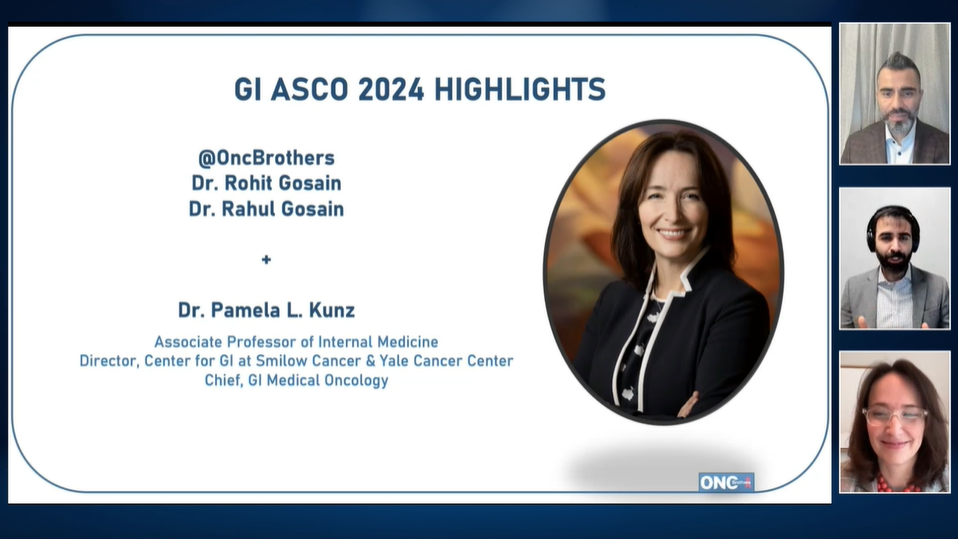Every Patient With a GI Tumor Should Have MSI Testing Done, Saif Says
Wasif Saif, MD, MBBS, recently talked about the treatment considerations and decisions he makes when treating patients with colorectal cancer. Saif explained his treatment decisions based on a case scenario during a <em>Targeted Oncology</em> live case-based peer perspectives presentation.
Wasif Saif, MD, MBBS

Wasif Saif, MD, MBBS
Wasif Saif, MD, MBBS, recently talked about the treatment considerations and decisions he makes when treating patients with colorectal cancer (CRC). Saif, a professor of medicine and director of the Gastrointestinal Oncology Program, Tufts University, explained his treatment decisions based on a case scenario during aTargeted Oncologylive case-based peer perspectives presentation.
Case
March 2016
A 50-year-old otherwise healthy woman received her first routine colonoscopy, and a suspicious mass in the sigmoid colon was detected. Her biopsy revealed poorly differentiated adenocarcinoma.
April 2016
She underwent a laparoscopic sigmoid resection and staged at T3N2 (stage IIIc).
June 2016
The patient began 6 months of adjuvant capecitabine plus oxaliplatin (CAPEOX).
May 2017
A CT of the abdomen, pelvis, and chest later showed diffuse bilateral liver nodules (≤5 mm). Her ECOG performance status was 0 at this time. Additionally, molecular testing on tissue biopsy was positive forKRASexon 2 codon 12 mutation. No mutations were noted inNRASorBRAFand she was microsatellite stable.
How has the treatment landscape changed over the years?
Many years ago, we were treating CRC with 5-FU only. Now we have many drugs, and it has become more complex to decide what should be given. Every drug has its own adverse events (AEs) and every study is done with a similar patient population. So, these drugs are compared with each other because of the same patient population, but then we have no randomized trials to compare them. It brings a lot of challenges for CRC.
At the same time, CRC is a cancer where we have more options for the majority of patients compared with the other gastrointestinal (GI) cancers.
At what age should colonoscopies be performed?
As of 2018, the [suggested starting] age is 45. That is very important. Anyone who is about 45 should have a colonoscopy done. Over the past decade, we realized that patients are developing colon cancer from age 46 to 50, based on cause and analysis. We are definitely seeing CRC much earlier than 50 years of age.
We never talk about colonoscopies as loud and as clear as mammograms, for example. That is the challenge for CRC. Colon cancer remains the third most common cancer among men and women. Whether you are a man or woman in the United States, if you are eating within this country, your risk of getting CRC is 6% to 7% over your lifetime. The [CRC-related mortality rate] in the United States remains approximately 68,000 per year. So, despite all the development of different agents, this is still the second cause of [cancer-related] death in the United States.
How does the patient’s molecular profiling influence your treatment decision?
This is a case of a [patient with]KRAS-mutated metastatic CRC. As you know, with precision medicine, there are some genetic markers that can help us decide on therapy or to not give therapy. These are our sole prognostic factors for these patients. AKRASmutation, for example, is a bad prognostic factor. However, at the same time, it tells you that certain drugs will not be beneficial.
This patient was also MSS, which is also a bad prognostic factor. We do not like stability of microsatellite, and we likeKRASto be wild. Both are poor prognostic factors, and this can not only help you out for this patient but also tell you that you cannot give certain kinds of drugs to this patient.
Do you typically order next-generation sequencing (NGS) for metastatic CRC?
I always do testing up front from day 1 for every patient because I don’t want to waste time. Unfortunately, the expectation for the disease to come back is around 35%, despite giving the patient CAPOX. When the patient has metastases, I don’t have too much time to play around, and these tests can take some time. I still have to remind my pathologists thatKRASand microsatellite instability (MSI) testing should be done on every patient with a GI tumor.
What locoregional therapies would you consider for this patient?
I would not do anything, because she has multiple small nodules on both sides, but I would think about it in the future. Let’s say the patient is getting FOLFOX and gets very bad neuropathy and rash, and you think that you can no longer continue the medication. Then I would say that maybe it is time to give the patient 5-FU or bevacizumab (Avastin) and do some kind of liver-directed therapy. A multidisciplinary approach is needed from day 1 so that you can treat as you feel is right for the patient.
What are the first-line options for systemic therapy?
FOLFIRI or FOLFOX plus bevacizumab are both reasonable options. Going back to a 2010 study, we know that FOLFOX and FOLFIRI are equal to each other. This patient was started on FOLFOX and bevacizumab for 8 cycles and did quite well.
You are trying to create a sequence, and you don’t want to use everything at once. Patients who are able to get the most drugs live the longest. That is key. Additionally, the quality of life is important. If this patient is someone you are not going to cure, why would you give her all the toxicities in the first 2 months to the point where she no longer wants chemotherapy? It is important to understand the intent of treatment for that patient.
June 2017
The patient initiated FOLFOX plus bevacizumab for 8 cycles and tolerated it well. A 4-month CT scan showed reduction in liver lesions, and the patient switched to maintenance. She continued on fluorouracil and folinic acid plus bevacizumab maintenance.
April 2018
Ten months after initiation of FOLFOX, the patient complained of a dry cough and shortness of breath on exertion. A CT of her abdomen, pelvis, and chest later showed multiple lung nodules in right pulmonary lobe. It was decided to start the patient with FOLFIRI and bevacizumab was continued.
July 2018
An increase in the patient’s carcinoembryonic antigen (CEA) was noted on last 2 follow-up labs. A CT of her abdomen, pelvis, and chest showed progression of lung disease, new lesion in the liver in close proximity to the bile duct, and diffuse peritoneal disease. Her ECOG performance status at this point was 1.
The patient continued to work in an office setting but reported that she sometimes left work early due to fatigue. She wanted to know her options for additional therapy, but she wanted to avoid infusion-based therapy and toxicities.
What are the treatment options for this patient after disease progression?
Now the disease has started to become refractory to the drugs and is becoming more and more progressive. Still, the patient is doing well with an ECOG performance status of 1. She no longer wants to receive any infusions, and she still wants to work, so the treatment options would be regorafenib (Stivarga) or trifluridine/tipiracil (TAS-102; Lonsurf). Again, she wants to work, and that will be the basis for the treatment decision. Regorafenib causes fatigue, hand-foot syndrome, and diarrhea, and TAS-102 causes neutropenia. You have to balance the toxicities versus the benefit. I would sit down with this patient and discuss the AEs associated with these drugs and understand what the patient wants. You are not going to cure the patient, unfortunately. It is all about buying them more time. Even if a patient needs a week to think about it, that’s fine. One week will not change the outcome.
Can you explain the outcomes of the RECOURSE trial?
The RECOURSE study was for patients who had failed more than 2 prior regimens.1They had a documented progression within the past 3 months. These patients were randomized in a 2:1 ratio to TAS-102 or placebo. There were 534 patients in the experimental arm versus 266 patients in the control arm. The primary endpoint was overall survival (OS), which was 7.2 months in the TAS-102 arm and 5.3 months in the placebo arm.
All the patients in the trial seemed to get the benefit. Additionally, TAS-102 seems to retain its benefit even when people have received more than 4 lines of therapy. That is the key element to keep in mind.
Can you explain the outcomes of the CORRECT study?
The same patient population was randomized to regorafenib or placebo. The median OS was 6.4 months in the regorafenib arm versus 5.0 months in the control arm.2This is still better than giving 12 days of erlotinib (Tarceva). That’s the good part about this trial.
About 47% of patients had fatigue, and about 10% had grade 3 and above fatigue. And fatigue can be painful. Hand-foot skin reaction is also 47%. When you get this AE, you cannot use your hands, and your feet feel funny, so you will not have a quality of life. Thirty-four percent of patients had diarrhea.
The beauty of oncology is that it is very numerical. If you know about the drug and its AEs, you can talk with the patient about what to do. It’s all based on what patients are willing to take on when it comes to AEs.
Is there a way to alleviate toxicities associated with regorafenib?
No human being on this earth was able to tolerate the 160 mg per day [dose of] regorafenib. What the ReDOS trial did was dose escalate to see if the patients could tolerate the drug better and if there was any difference in efficacy.3It was a small study of just 123 patients. The primary endpoint was to see how many patients were able to tolerate 2 cycles and start the third cycle. This is a hypothetical study, and they were not trying to get anything else from the trial.
They realized about 43% of patients were able to get on to cycle 3 when they started from the lower dose of 80 mg versus 25% for people who got the full dose. In my practice, I give them 80 mg the first time I see them, and the second time I see them is 1 week later. If they are doing well, I will go to 120 mg. Then they come back the next week and I give them 160 mg if they are still tolerating the drug. I try to follow them very closely for the full cycle. Honestly, the hand-foot skin reaction occurs in the initial cycles, and then goes away.
Let’s say the patient is getting regorafenib but is very fatigued. What would you do?
You can give them methylphenidate (Ritalin). Don’t forget to get out of the box. I always say that I don’t treat cancer, I treat patients with cancer. You have to look at everything and be brave. At the end of the day, all you need to do is provide a rationale for your decisions.
References:
- Mayer RJ, Van Cutsem E, Falcone A, et al; RECOURSE Study Group. Randomized trial of TAS-102 for refractory metastatic colorectal cancer.N Engl J Med. 372(20):1909-1919. doi: 10.1056/NEJMoa1414325.
- Grothey A, Van Cutsem E, Sobrero A, et al; CORRECT Study Group. Regorafenib monotherapy for previously treated metastatic colorectal cancer (CORRECT): an international, multicentre, randomised, placebo-controlled, phase 3 trial.Lancet. 2013;381(9863):303-31 doi: 10.1016/S0140-6736(12)61900-X.
- Bekaii-Saab TS, Ou F-S, Anderson DM, et al. Regorafenib dose optimization study (ReDOS): randomized phase II trial to evaluate dosing strategies for regorafenib in refractory metastatic colorectal cancer (CRC)an ACCRU Network Study.J Clin Oncol. 2018;36(suppl 4S; abstr 611). meetinglibrary.asco.org/record/155600/abstract.








